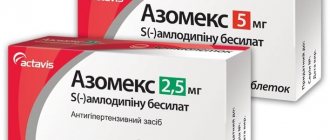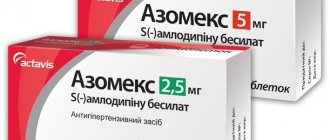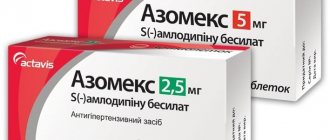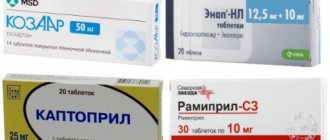Parnavel, 8 mg, capsules, 30 pcs.
Stable ischemic heart disease
If an episode of unstable angina (significant or not) develops during the first month of therapy with Perindopril, it is necessary to assess the benefit/risk ratio of therapy with this drug.
Arterial hypotension
ACE inhibitors can cause a sharp decrease in blood pressure. In patients with uncomplicated hypertension, symptomatic hypotension rarely occurs after the first dose.
The risk of excessive reduction in blood pressure is increased in patients with reduced circulating blood volume (CBV) during diuretic therapy, while following a strict salt-free diet, hemodialysis, as well as with diarrhea or vomiting, or with severe renin-dependent arterial hypertension. Severe arterial hypotension was observed in patients with severe CHF, both in the presence of concomitant renal failure and in its absence. The most common arterial hypotension can develop in patients with more severe CHF, taking loop diuretics in high doses, as well as against the background of hyponatremia or renal failure. These patients are recommended to undergo careful medical supervision during initiation of therapy and during dosage titration. The same applies to patients with coronary artery disease or cerebrovascular diseases, in whom an excessive decrease in blood pressure can lead to myocardial infarction or cerebrovascular complications. If arterial hypotension develops, it is necessary to place the patient in a horizontal position with raised legs, and, if necessary, administer a 0.9% sodium chloride solution intravenously to increase the volume of blood volume. Transient arterial hypotension is not a contraindication for further therapy. After restoration of blood volume and blood pressure, treatment can be continued subject to careful selection of the dose of the drug. In some patients with CHF and normal or low blood pressure, an additional decrease in blood pressure may occur during therapy with Perindopril. This effect is expected and is usually not a reason to discontinue the drug. If arterial hypotension is accompanied by clinical manifestations, it may be necessary to reduce the dose or discontinue the drug Perindopril.
Renal dysfunction
In patients with renal failure (creatinine clearance less than 60 ml/min), the initial dose of Perindopril should be adjusted in accordance with the clinical clearance and then depending on the therapeutic response. For such patients, it is necessary, depending on the level of potassium and creatinine in the blood serum. In patients with symptomatic heart failure, arterial hypotension that develops during the initial period of therapy with ACE inhibitors can lead to deterioration of renal function.
Cases of acute renal failure, usually reversible, have sometimes been reported in such patients. In some patients with bilateral renal artery stenosis or renal artery stenosis of a solitary kidney (especially in the presence of renal failure), an increase in serum concentrations of urea and creatinine was observed during therapy with ACE inhibitors, which was reversible after discontinuation of therapy. In patients with renovascular hypertension during therapy with ACE inhibitors, there is an increased risk of developing severe arterial hypotension and renal failure. Treatment of such patients should begin under close medical supervision, with small doses of the drug and with further adequate dose selection. During the first weeks of therapy with Perindopril, diuretics should be discontinued and renal function should be regularly monitored.
In some patients with arterial hypertension, in the presence of previously undetected renal failure, especially with concomitant diuretic therapy, there was a slight and temporary increase in serum urea and creatinine concentrations. In this case, it is recommended to reduce the dose of Perindopril and/or discontinue the diuretic.
Hemodialysis patients
Several cases of persistent, life-threatening anaphylactic reactions have been reported in patients undergoing dialysis using high-flux membranes and concomitantly taking ACE inhibitors. If hemodialysis is necessary, a different type of membrane must be used.
Kidney transplant
There is no experience with the use of Perindopril in patients with recent kidney transplantation.
Hypersensitivity, angioedema
Rarely in patients taking ACE inhibitors, incl. perindopril, angioedema of the face, extremities, lips, tongue, vocal folds and/or larynx developed. This condition can develop at any time during treatment. If angioedema develops, treatment should be stopped immediately, and the patient should be under medical supervision until symptoms disappear completely. Angioedema of the lips and face usually does not require treatment; Antihistamines can be used to reduce the severity of symptoms. Angioedema of the tongue, vocal folds, or larynx can be fatal. If angioedema develops, it is necessary to immediately administer epinephrine (adrenaline) subcutaneously and ensure airway patency. ACE inhibitors are more likely to cause angioedema in black patients. Patients with a history of angioedema not associated with the use of ACE inhibitors may be at high risk of developing angioedema while taking an ACE inhibitor.
Anaphylactoid reactions during low-density lipoprotein apheresis (LDL apheresis).
In patients prescribed ACE inhibitors during the procedure of LDL apheresis using dextran sulfate absorption, in rare cases, an anaphylactic reaction may develop. It is recommended to temporarily discontinue the ACE inhibitor before each apheresis procedure.
Anaphylactic reactions during desensitization
In patients receiving ACE inhibitors during a course of desensitization (for example, hymenoptera venom), in very rare cases, life-threatening anaphylactic reactions may develop. It is recommended to temporarily discontinue the ACE inhibitor before each desensitization procedure.
Liver failure
During therapy with ACE inhibitors, it is sometimes possible to develop a syndrome that begins with cholestatic jaundice and then progresses to fulminant liver necrosis, sometimes with death. The mechanism of development of this syndrome is unclear. If jaundice occurs or an increase in liver enzyme activity occurs while taking an ACE inhibitor, the ACE inhibitor should be discontinued immediately and the patient should be closely monitored. It is also necessary to conduct an appropriate examination.
Cases of neutropenia, agranulocytosis, thrombocytopenia and anemia have been reported in patients treated with ACE inhibitors. With normal renal function in the absence of other complications, neutropenia rarely develops. The drug Perindopril should be used with great caution in patients with systemic connective tissue diseases (for example, SLE, scleroderma), simultaneously receiving immunosuppressive therapy, allopurinol or procainamide, as well as when combining all of these factors, especially with existing renal impairment. Such patients may develop severe infections that do not respond to intensive antibiotic therapy. When carrying out therapy with Perindopril in patients with the above factors, it is recommended to periodically monitor the number of leukocytes in the blood and warn the patient about the need to inform the doctor about the appearance of any symptoms of infection.
In patients with congenital deficiency of glucose-6-phosphate dehydrogenase, isolated cases of hemolytic anemia have been reported.
Negroid race
The risk of developing angioedema in black patients is higher. Like other ACE inhibitors, perindopril is less effective in lowering blood pressure in black patients, possibly due to the higher prevalence of low-renin conditions in this population of patients with arterial hypertension.
Cough
During therapy with ACE inhibitors, a persistent, non-productive cough may develop, which stops after discontinuation of the drug. This should be taken into account in the differential diagnosis of cough.
Surgery and general anesthesia
In patients whose condition requires major surgery or general anesthesia with drugs that cause hypotension, ACE inhibitors, including perindopril, may block the formation of angiotensin II with compensatory renin release. One day before surgery, therapy with ACE inhibitors must be discontinued. If the ACE inhibitor cannot be canceled, then arterial hypotension, which develops according to the described mechanism, can be corrected by increasing the volume of blood volume.
Hyperkalemia
During therapy with ACE inhibitors, including perindopril, potassium levels in the blood may increase in some patients. The risk of hyperkalemia is increased in patients with renal and/or heart failure, decompensated diabetes mellitus and in patients using potassium-sparing diuretics, potassium supplements or other drugs that cause hyperkalemia (for example, heparin). If it is necessary to prescribe these drugs simultaneously, it is recommended to regularly monitor the potassium content in the blood serum.
Diabetes
In patients with diabetes mellitus taking oral hypoglycemic agents or insulin, blood glucose concentrations should be carefully monitored during the first few months of ACE inhibitor therapy.
Impact on the ability to drive vehicles and operate machinery
It should be used with caution in patients driving vehicles and engaged in activities that require increased concentration and quick reaction, due to the risk of developing arterial hypotension and dizziness.
Parnavel Amlo tablets 10mg+4mg bl N30x1 Ozone
Perindopril. Perindopril is an inhibitor of the enzyme that converts angiotensin I to angiotensin II (ACE inhibitor). Angiotensin-converting enzyme, or kininase II, is an exopeptidase that both converts angiotensin I into the vasoconstrictor angiotensin II and breaks down the vasodilator bradykinin into an inactive heptapeptide. Since ACE inactivates bradykinin, suppression of ACE is accompanied by an increase in the activity of both the circulating and tissue kallikrein-kinin system, while the prostaglandin system is also activated. Perindopril has a therapeutic effect due to its active metabolite, perindoprilat. Other metabolites do not have an inhibitory effect on ACE. Arterial hypertension. Perindopril is a drug for the treatment of arterial hypertension of any severity. Against the background of its use, there is a decrease in both systolic and diastolic blood pressure (BP) in the “lying” and “standing” positions. Perindopril reduces total peripheral vascular resistance, which leads to a decrease in high blood pressure and improvement in peripheral blood flow without changing heart rate (HR). As a rule, taking perindopril increases renal blood flow, while the glomerular filtration rate does not change. The antihypertensive effect of the drug reaches its maximum 4-6 hours after a single oral dose and persists for 24 hours. The antihypertensive effect 24 hours after a single oral dose is about 87-100% of the maximum antihypertensive effect. A decrease in blood pressure is achieved quite quickly. The therapeutic effect occurs in less than 1 month from the start of therapy and is not accompanied by tachycardia. Stopping treatment does not cause withdrawal syndrome. Perindopril has a vasodilating effect, helps restore the elasticity of large arteries and the structure of the vascular wall of small arteries, and also reduces left ventricular hypertrophy. Stable coronary heart disease (CHD). The effectiveness of perindopril in patients with stable coronary artery disease without clinical symptoms of chronic heart failure led to a significant reduction in the absolute risk of complications in patients who had previously suffered a myocardial infarction or a revascularization procedure. Amlodipine. Amlodipine is a slow calcium channel blocker (SCCC), a dihydropyridine derivative. Amlodipine inhibits the transmembrane transition of calcium ions into cardiomyocytes and smooth muscle cells of the vascular wall. The antihypertensive effect of amlodipine is due to a direct effect on the smooth muscle cells of the vascular wall. It has been established that amlodipine: causes dilation of peripheral arterioles, reducing the total peripheral vascular resistance (afterload), since heart rate does not change and the myocardial oxygen demand is reduced. causes expansion of the coronary arteries and arterioles in both ischemic and intact zones. In patients with Prinzmetal's angina, coronary blood flow improves. In patients with arterial hypertension (AH), taking amlodipine once a day provides a clinically significant decrease in blood pressure in the standing and lying position for 24 hours. The antihypertensive effect develops slowly, and therefore the development of acute arterial hypotension is uncharacteristic. In patients with angina pectoris, taking amlodipine once a day increases exercise tolerance, delays the onset of an attack of angina and “ischemic” depression of the ST segment, and also reduces the frequency of angina attacks and the consumption of nitroglycerin (short-acting forms). Amlodipine has no effect on the lipid profile and does not cause changes in lipid-lowering parameters of blood plasma. The drug can be used in patients with concomitant bronchial asthma, diabetes mellitus and gout. Cardiac ischemia. The results of the efficacy assessment indicate that amlodipine is characterized by fewer hospitalizations for angina and revascularization procedures in patients with coronary artery disease. Amlodipine + Perindopril. The main criterion for assessing the effectiveness of long-term use of amlodipine in combination with perindopril is a combined indicator of the incidence of non-fatal myocardial infarction (including painless) and fatal outcomes of coronary artery disease. The incidence of complications decreases when amlodipine is used in combination with perindopril.




